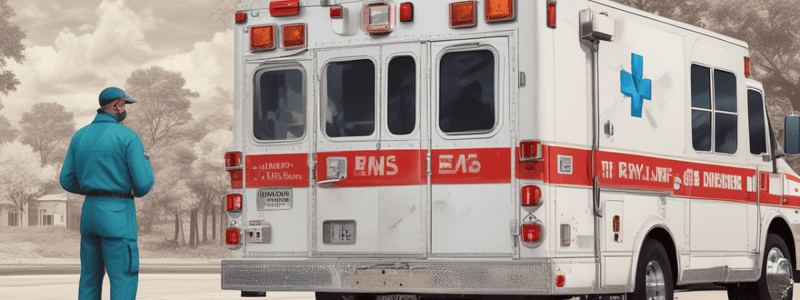Podcast
Questions and Answers
A patient presents with labored breathing, using accessory muscles, and retractions. Which of the following interventions should be considered first based on the provided text?
A patient presents with labored breathing, using accessory muscles, and retractions. Which of the following interventions should be considered first based on the provided text?
- Evaluating the patient's level of consciousness using the AVPU scale
- Administering supplemental oxygen at 1-6 liters per minute via nasal cannula (correct)
- Assessing lung sounds to determine the cause of the labored breathing
- Performing a head-to-toe assessment to identify any other potential life threats
What is the primary goal of performing assessments and initial interventions on patients at the point of contact?
What is the primary goal of performing assessments and initial interventions on patients at the point of contact?
- To ensure the patient remains in a stable environment for the longest possible time
- To allow EMS personnel to practice advanced medical techniques without supervision
- To obtain complete information for appropriate treatment without delay (correct)
- To prioritize patient consent above all other considerations
In a situation requiring resuscitative interventions, what should be the sequence of care during the primary assessment?
In a situation requiring resuscitative interventions, what should be the sequence of care during the primary assessment?
- Delay any interventions until additional resources arrive
- Perform interventions only after completing a full patient history
- Progress care from basic life support to advanced life support as necessary (correct)
- Start advanced life support immediately regardless of patient condition
What is included in the initial scene size-up during patient assessment?
What is included in the initial scene size-up during patient assessment?
What should EMS personnel do if they encounter a potential crime scene during patient assessment?
What should EMS personnel do if they encounter a potential crime scene during patient assessment?
Why is it important to consider the number of patients during the scene assessment?
Why is it important to consider the number of patients during the scene assessment?
What should EMS personnel wear when there is a potential for exposure to blood or body substances?
What should EMS personnel wear when there is a potential for exposure to blood or body substances?
Study Notes
General Patient Assessment
- Assessments and initial interventions should be performed on all patients at the point of contact, unless it is unsafe, with patient consent.
- Monitoring and intervention equipment/devices should be brought to the patient to obtain complete information for appropriate level of care without delay.
Scene Size Up
- Includes situational awareness and dynamic risk assessment
- Assess and intervene as needed for:
- Scene safety and control of hazards
- Removal of patient/crew from unsafe environment ASAP
- Preservation of evidence in potential crime scenes
- Nature of illness and scanning environment for clues
- DNR/POLST orders
- Universal blood/body secretion and sharps precautions
- Number of patients and triage
- Requesting additional resources if needed
- Weighing risk of waiting for resources against benefit of rapid transport to definitive care
- Consideration for medium or large scale MPI declaration
Primary Assessment
- Establish rapport with patient and significant others
- General impression: age, gender, general appearance, position, and purposeful movements
- Determine if immediate life threat exists and resuscitate as found
- Level of consciousness using AVPU or GCS
- Chief complaint and signs and symptoms
- AIRWAY:
- Assess for snoring, gurgling, stridor, or silence
- Consider possible spine injury
- Open/maintain airway using position, suction, and adjuncts
- Follow AIRWAY OBSTRUCTION SOP if obstructed
- Loosen tight clothing and provide vomiting and seizure precautions as indicated
- BREATHING:
- Assess for hypoxia or hypercarbic ventilatory failure
- Evaluate spontaneous ventilations, rate, depth, effort, and accessory muscle use
- Assess position, adequacy of air movement, and symmetry of chest expansion
- Check for lung sounds and signs of ventilatory distress
- Monitor SpO2 for possible hypoxia, cardiovascular compromise, or neurological compromise
- Note signs and symptoms of hypoxemia and hypercarbia
- Correct hypoxia and assure adequate ventilations: target SpO2 94%-98% (88%-92% COPD) unless hyperoxia is contraindicated
Studying That Suits You
Use AI to generate personalized quizzes and flashcards to suit your learning preferences.
Related Documents
Description
Learn about the importance of patient assessments and initial medical care in Emergency Medical Services (EMS). This quiz covers the guidelines for EMS personnel to follow during patient encounters.




